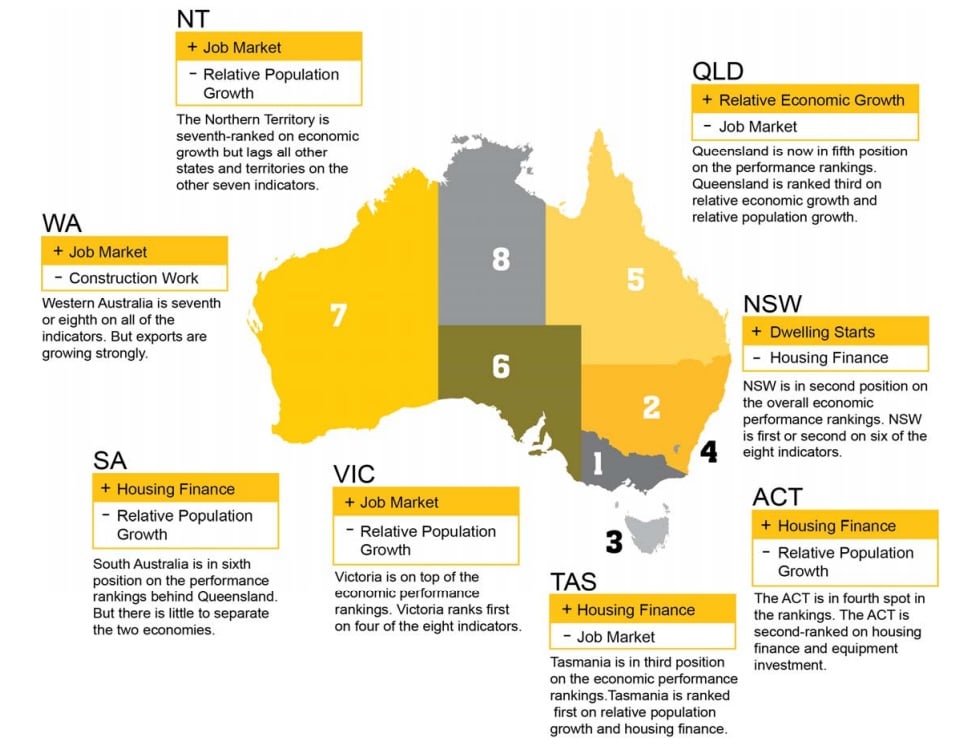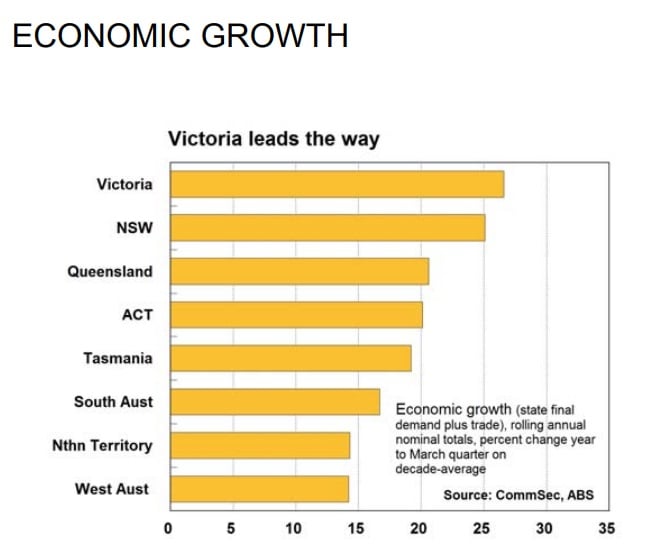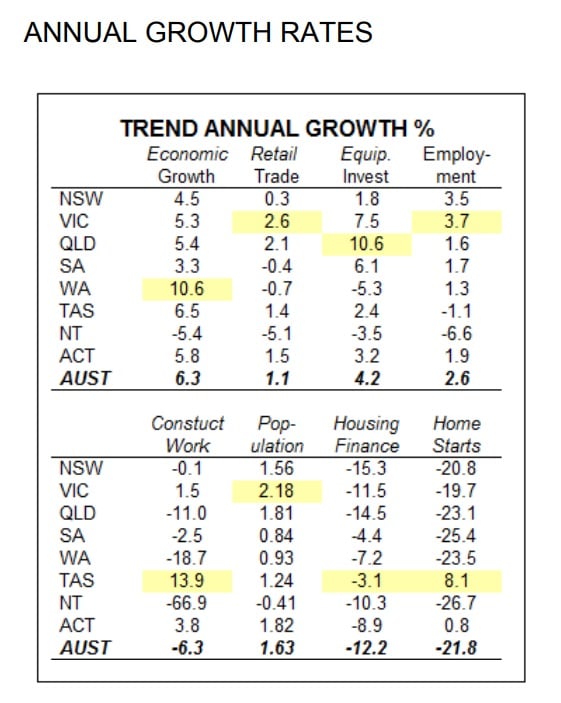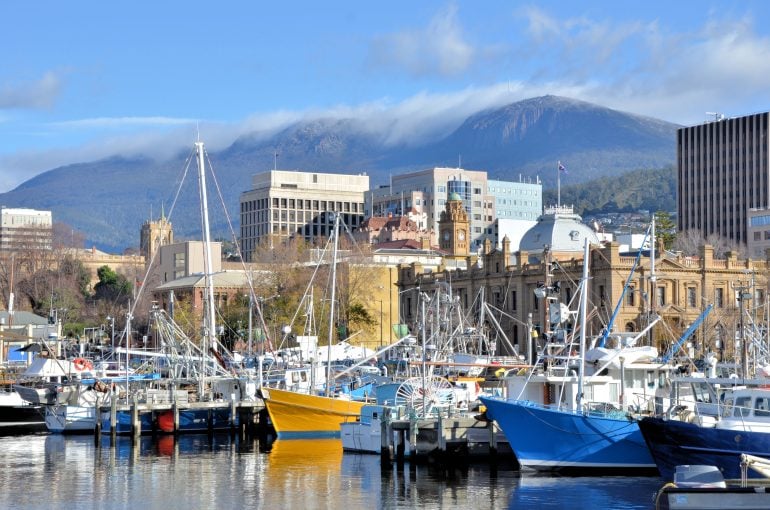Hobart, Tasmania, where the economy is booming. Source: AdobeStock
Victoria has the nation’s best performing economy, with NSW slipping from equal top spot in CommSec’s latest quarterly State of the States report.
For the first time in three surveys, Victoria is number one, a position previously shared with its northern rival, while Tasmania, boosted by population growth and housing construction, is in third spot pipping the ACT, now in fourth.
Solid population growth and a strong job market helped Victoria take the lead, although Commsec noted that NSW remained consistently strong across all indicators and there is little to separate the two economies.
CommSec analyses eight key indicators: economic growth; retail spending; equipment investment; unemployment; construction work done; population growth; housing finance and dwelling commencements, to compare each Australian state and territory and their economic performance, comparing current performance with decade averages.
State of the States snapshot

Source: CommSec
CommSec chief economist Craig James said the difference between the two states was that Victoria’s economy strengthened rather than NSW’s weakened. Victoria’s construction work done is 30.1% above its decade-average.
There is a gap in growth to Queensland in fifth spot, ahead of South Australia, but the bank’s trading arm noted there is little to separate the two economies. Western Australia remains in seventh position, ahead of Northern Territory.
Over the quarter Victoria lifted two places on dwelling starts and gained one spot on equipment investment, while NSW fell two places on business investment despite taking top spot on dwelling starts.
The findings come just weeks after the NSW government axed the Jobs for NSW board charged with investing $190 million into emerging businesses in the state.
Victoria ranked first for the quarter for economic growth, retail trade, the job market and construction work done. Victoria’s lowest ranking is fourth on relative population growth.
Tasmania ranked first on relative population growth, housing finance and business investment and is in second spot on dwelling starts.
Such is the strength of the Apple Isle, CommSec believes the island state could challenge Victoria and NSW for top position in the year ahead. And people are flocking south. Tasmania’s annual population growth of 1.24% is the fastest rate in 27 years. Only NSW pipped Tasmania for dwelling starts.

Economic growth in Australia’s states and territories. Source: CommSec
While retail sales are viewed as modest at a national level – last month the Australian Bureau of Statistics (ABS) released figures with year-on-year growth of 2.84% in April, falling from the March figure of 3.51% – Melbourne appears to be the country’s shopping capital, with the CommSec report finding retail spending in Victoria 16.6% above decade-average levels in the March quarter.
Strong population growth, low unemployment, increased job security and infrastructure building were key supports for retail spending.
Retail spending in NSW was 14.3% above decade-average levels, and up 12.7% in the ACT, followed by Tasmania, up 11.7%.
On the employment front, CommSec found the trend jobless rate in the ACT of 3.4% is the lowest of all economies and 13.6% lower than its ‘normal’ or decade-average rate.
Victoria’s unemployment rate, while higher at 4.7%, is actually 16.5% below its decade-average, putting it ahead of the ACT on this indicator.
That strong performance likely helped wage growth in the year to March, which was strongest in Victoria at 2.7%, ahead of Tasmania, up by 2.5%. Wages in Western Australia were up by only 1.6%.
Equipment investment in Victoria is at 9-year highs with Queensland equipment spending at 4-year highs.
Housing finance continued its collapse in every region, with NSW with the biggest annual fall at 15.3%.
Housing loan commitments are seen as a lead indicator for other economic activity. Only three regions now have trend housing finance commitments above decade averages, down from four last quarter. Tasmania is now in top spot with the number of commitments up by 11.3% on the long-term average, although it remains down 3.1% on an annual basis. Next strongest is the ACT (up 8.6%), followed by Victoria (up 1.9%).
The Northern Territory remains the weakest for housing finance with trend commitments 29.6% lower than its decade-average. Commitments in Western Australia were down 27.7% , followed by Queensland, down 10.8%, NSW (down 7.3%) and South Australia (down 3.7%).
While Western Australia and the Northern Territory sit at the back of the economic growth pack, they both posted strong rises in exports. Rolling annual exports in Western Australia are up 21.1% on a year ago with exports up 40.9% in the Northern Territory.
The biggest issue facing the Northern Territory is that its population continues to shrink. The NT’s population shrank by 0.41% over the past year – the biggest decline in 36 years of quarterly records.

Annual trend growth in the states, with the best performers highlighted. Source: CommSec




















Trending
Daily startup news and insights, delivered to your inbox.